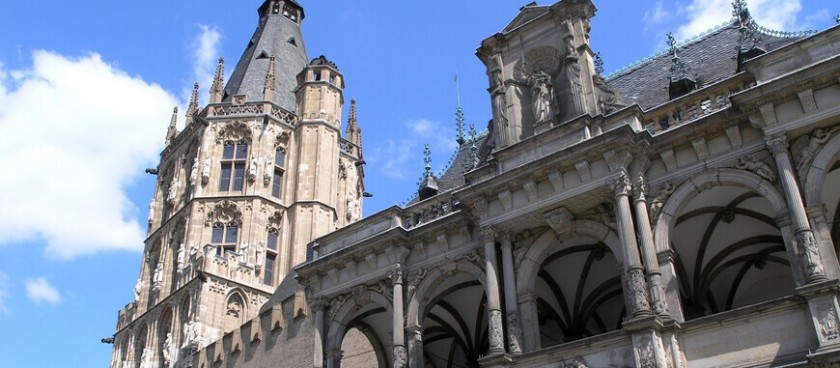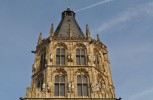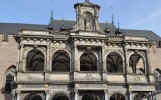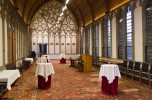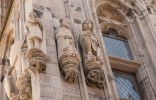- #DE39
- Rathauspl. 2, 50667 Köln, Germany
- +492212210
- stadtverwaltung@stadt-koeln.de
- http://www.stadt-koeln.de/
- Working hours*:
Monday, Wednesday, Thursday - from 08.00. until 16.00.
Tuesday - from 08.00. until 18.00.
Friday - from 08.00. until 12.00. - * - opening and closing times as well as entrance prices, are subject to alterations without notice. Visitors are advised to check before visiting.
- 50.9381873, 6.9589978 Copy to clipboard Copy
-
#Viewpoints
The first mention of "the house in which the city's citizens gather" dates back to 1135.
Cologne Town Hall is considered the oldest town hall in Germany. And the history of the construction of the town hall stretched for 800 years.
Archaeological excavations have shown that part of the foundation of the town hall stands on the remains of the fortress wall of the Roman settlement of Colonia, from whose name the modern name of the city of Cologne derives.
The first building of the town hall was a two-storey building in the Romanesque style. The oldest part of the building that has survived to this day dates back to 1330. In the 14th century, the town hall rebuilt in the Gothic style. The entire second floor now occupied by one long corridor. The Jewish pogroms of 1349 in the neighbouring Jewish Quarter also damaged the town hall.
With the transfer of the city government to the so-called Gaffel, the union of artisans' guilds decided to add a tower (beffroy) to the town hall, which later became the most famous part of the whole complex town hall buildings. In the 15th century, added a splendid Renaissance gallery to the main entrance to the town hall building. In the 16th century, a courtyard with arches added to the side of the town hall tower.
On the side of the Town Hall Square in the 17th century, the Town Hall Chancellery, now called the Spanish Building, was built. Unfortunately, its historic building has not survived. Hence, the modern Spanish building erected in 1956.
During the Second World War, the Cologne City Hall severely damaged. Restoration work continued until the seventies of the XX century. After that, however, it is decided not to restore most of the building. Instead, the so-called Piazzetta, a glass and concrete building with modern graphics and installations, is open to the public.
What to see
Even though most of the historical building of the city hall of Cologne has not survived, the remaining buildings tell a lot about the history of the city.
Townhall tower
The construction of the Town Hall Tower (Ratsturm) in the Gothic style carried out from 1407 to 1414. The shape of the tower resembles Belfrid, which often found in Dutch and Belgian cities.
The quadrangular Ratsturm, with a total height of 61 meters, has three floors and two additional octagonal levels. Initially, it planned to place the treasury and the city treasury in the tower building.
The upper floor, the so-called Kure, was used as a fire observation post. The tower also housed a wine cellar and a meeting room of the city senate.
Sculptures on the town hall tower
Each floor of the tower decorated with sculptures of emperors, kings, saints and patrons of Cologne and its famous inhabitants. Historical figures, made of sandstone, under the influence of time and weather conditions, collapsed but were replaced with their exact copies.
In the post-war period, restored the sculptures destroyed by the bombing. In addition, they added new ones - the city council decided to perpetuate the memory of today's prominent natives and residents of Cologne. Thus, the sculptures on the town hall tower arranged according to their lifetime.
The sculptures placed on the tower of the Cologne City Hall can trace to the entire glorious history of the ancient city on the Rhine.
On the tower's first floor, there are figures of emperors, kings, popes, starting with Gaius Julius Caesar and Agrippina, the Younger's founder.
The second floor of the town hall tower houses the famous inhabitants of Cologne, who lived from the 8th to the 17th century.
The second level houses a controversial sculptural composition depicting the Bishop of Cologne Konrad von Hochstaden on a pedestal in the form of a figure engaged in autofellatio. The city hated Hochstaden; being an adherent of the papal party, he deprived Cologne of independence but weakened the power of the patricians by raising the guilds. And his main merit is considered to be the foundation of the famous Cologne Cathedral. In any case, the name of the bishop immortalized in the city hall.
The third floor is dedicated to the famous inhabitants of Cologne from the 17th to the 19th centuries - generals, poets, historians, and Johann Maria Farina - perfumer, inventor of Cologne and Karl Marx.
On the fourth floor are the famous inhabitants of Cologne of the 19th - 20th centuries. Among them - Nikolaus Otto, one of the inventors of the internal combustion engine; Max Isidor Bodenheimer, one of the founders of the World Zionist Organization; Konrad Adenauer, the first Federal Chancellor of the Federal Republic of Germany.
The saints and patrons of Cologne guard the fifth floor.
Jingle bells
A carillon with 45 bronze bells installed on the tower of the Cologne town hall in 1858. The bells play one of 24 pre-programmed melodies every day.
Platzjabbek
On the eastern side of the tower, from the side of the Alter Markt, under the clock, there is another unusual attraction - Platzjabbek (from the Cologne dialect - "opening mouth") - head that every hour shows the language to all passers-by.
Platsyabbek installed on the tower in the 15th century; in this way, the bourgeois demonstrated their victory over the patricians during the transfer of power into their hands.
Front entrance
The gallery, built at the entrance to the town hall at the beginning of the 15th century, was replaced in the 16th century.
The new two-story gallery was supposed to decorate the western part of the city hall—instead, the friezes on the first floor decorated with medallions depicting the profiles of Roman emperors.
The reliefs on the second floor symbolize the strength and power of the city senate. The side reliefs tell the story of the city. A statue of Justitia installed in a niche on the second floor.
Hanseatic hall
Initially, the hall called Long (its length is 30 meters) until, in 1367, the historic meeting of the cities of the Hanseatic League took place here, which decided to unite in the war against the Danish king Waldemar IV (Waldemar IV). Since then, this hall has been called the Hanseatic (Hansesaal).
The Hanseatic Hall was located on the second floor of the Cologne City Hall and rebuilt in its original Gothic style after World War II.
On the south side of the hall is the impressive altar relief "Nine Heroes", depicting, for example, Alexander the Great, Hector and Julius Caesar, King Arthur, Kaiser Charlemagne, and dating back to the 15th century.
How to get there
The Cologne City Hall located in the central part of the old town. It can easily reach by any means of transport.
By public transport
The town hall can reach by train, city train, bus, as well as on foot.
By train: get to the central train station, and then the easiest way is on foot - it is about 600 meters.
By city train Stadtbahn: lines S3, S4, S5, S16, S18 - to the Appelhofplatz stop, then about 10 minutes on foot, or routes S5, S6, S18 to the main railway stop. train station (Hauptbahnhof), then 10 minutes on foot.
By bus: route 132 to stop Dom, or routes 106, 132, 133, 250, 260, N26 to stop Heumarkt, then walk for five minutes.
By car
Due to the traffic congestion in the central part of Cologne, it recommended using public transport in the centre. There are several car parks in the Cologne town hall area.
